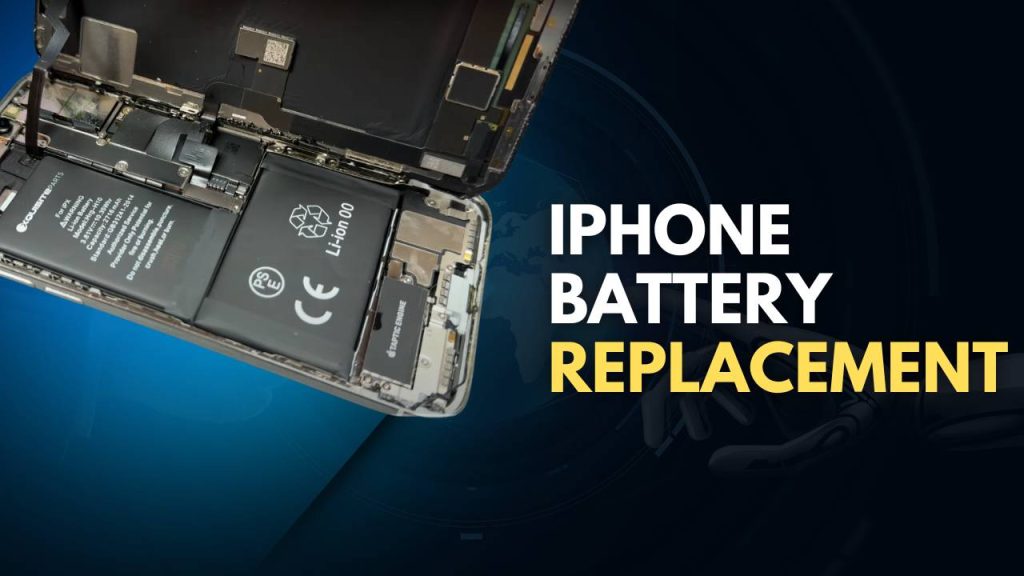As an everyday iPhone user and tech-savvy reporter, I’ve seen how battery issues can quietly sneak up on users—causing slowdowns, sudden shutdowns, and reduced performance. That’s why iPhone battery replacement is one of the smartest moves you can make when your phone starts falling behind.
If looking for fast, reliable, and lasting mobile issue solutions, replacing your iPhone battery at the right time can significantly boost your device’s lifespan and performance.
How to Do iPhone Battery Replacement at Home
Explain the entire process: the ideal time to replace your iPhone battery, step-by-step instructions, the cost breakdown by model, and mistakes to avoid—ensuring your investment in a replacement battery pays off for years.
iPhone Battery Replacement Time and Process
Average iPhone battery replacement takes 45 minutes to 2 hours if you’re visiting an Apple Store or authorized service center. For mail-in repairs, expect about 3–5 business days including shipping. But remember—time also depends on your location, technician availability, and parts in stock.
Apple-certified technicians follow strict guidelines to open your device, remove the old battery using heat and suction tools, apply fresh adhesive strips, and seal the device back with waterproofing if applicable. iPhones from iPhone 12 onward also require delicate handling to protect Face ID modules and wireless charging coils during this process.
If you’re doing it yourself, set aside at least 3 hours, especially if it’s your first time. Ensure you have the right tools: pentalobe screwdriver, suction cup, spudger, tweezers, and Apple-certified battery. Self-repair kits are now available for iPhones 12 and later, but come with a learning curve.
Pro tip: Even with a fast service time, always allow for post-replacement calibration to improve battery accuracy and long-term performance. Apple also advises running a diagnostic to make sure no other battery-related issues exist.
Best Time to Get iPhone Battery Replacement
Right time for iPhone battery replacement is when your phone’s battery health dips below 80%, or you notice slower app loading, inconsistent charging, and frequent overheating. iOS even alerts you with a message: “Your battery’s health is significantly degraded.”
But don’t wait for that message. Be proactive if:
- Your battery life doesn’t last a full day even on light use.
- Your iPhone randomly shuts down, especially at 20–30%.
- Charging takes much longer than it used to.
- The battery gets hot while using simple apps or during charging.
Also, for iPhones more than 2.5 years old, even if battery health is 81–85%, performance drops are likely. The lithium-ion cells degrade slowly, but consistently, especially in hot climates or when fast-charging daily.
Selling your iPhone soon? A fresh battery can improve resale value by $50–$100 depending on the model. If you’re a heavy user—gaming, 4K video, navigation—battery replacement every 24–30 months ensures optimal device health.
Best Kits for iPhone Battery Replacement
iPhone Battery Replacement: Step-by-Step Tutorial
Whether going through Apple, a certified technician, or replacing the battery yourself, here’s your comprehensive guide to get it right—without risking your data or device.
Step 1: Check Battery Health
Navigate to: Settings > Battery > Battery Health & Charging
Start by assessing your iPhone’s current battery performance. The “Maximum Capacity” percentage reflects your battery’s health compared to when it was new. If it’s below 80%, your phone won’t hold charge like it used to, and performance might degrade.
Additionally, check “Peak Performance Capability.” If it displays messages like “performance management has been applied,” your iPhone is throttling performance to avoid unexpected shutdowns—a major sign it’s time for a new battery.
In newer models, Apple may also display a service recommendation like “Battery health significantly degraded.”
Tip: For older iPhones, sluggish performance and rapid battery drain are also signs of battery deterioration, even if the health says 80–85%.
Step 2: Back Up Your iPhone
Methods:
- iCloud: Go to
Settings > [your name] > iCloud > iCloud Backup > Back Up Now. Ensure Wi-Fi is stable and your storage has space.
- Mac/Finder: Connect your iPhone and click “Back Up Now” under the device tab.
- Windows/iTunes: Use the latest iTunes version and select “Back Up Now.”
Backing up is a critical safety step. Even Apple-certified repairs can run into glitches. A backup ensures your contacts, messages, apps, and photos are safe.
If you’re doing a DIY battery replacement, backup becomes even more important since you’ll be working near the logic board and battery connections that are sensitive.
Bonus Tip: For peace of mind, do both iCloud and computer backups.
Step 3: Book a Repair
Options include:
- Apple Support App / website
- Apple Authorized Service Providers (AASP)
- Best Buy Geek Squad (Apple certified in the U.S.)
- uBreakiFix (also certified and sometimes faster for walk-ins)
Booking in advance helps avoid long queues and ensures parts are in stock for your model.
You’ll be shown the estimated cost, warranty information, and repair time. Apple typically completes repairs within 1–3 hours, but availability can vary depending on the location and iPhone model.
Pro Tip: Check your warranty status at checkcoverage.apple.com. If your iPhone is under AppleCare+, battery replacement may be free or discounted.
Step 4: Prepare Your Device
Before handing your iPhone over, do the following:
- Turn off Find My iPhone: Go to
Settings > [Your Name] > Find My > Find My iPhoneand toggle off. You’ll need your Apple ID password. - Unpair your Apple Watch: If paired, go to the Watch app and unpair to avoid connectivity issues.
- Remove accessories: Take off the case, screen protector, SIM card, and any other connected items.
This protects your privacy, prevents hardware damage during handling, and helps technicians complete the repair smoothly. Some stores won’t accept devices for repair until Find My is disabled, as a security policy.
Pro Tip: Also make a note of your passcode if you need to share it for post-repair testing.
Step 5: Battery Replacement Procedure
Here’s what happens during the actual replacement:
- Heating Pad or iOpener Tool: Applied to soften adhesive sealing the screen.
- Suction Cups or Pry Tools: Carefully used to lift the display without cracking it.
- Internal Shielding: Screws are removed, exposing battery connectors and logic board.
- Battery Removal: The technician detaches the battery adhesive strips, avoiding contact with sensitive parts.
- New Battery Placement: Installed using alignment guides and adhesive pads.
- Reassembly: Screen and other components are reattached securely.
Apple-certified techs use genuine OEM batteries with proper ESD-safe tools. For DIY, always use a reliable battery kit with tools and instructions specific to your iPhone model.
Caution: A poorly installed battery can cause overheating, boot loops, or even fire.
Step 6: Post-Replacement Calibration
To ensure iOS properly reads your new battery, follow this post-replacement routine:
- Fully charge to 100% without interruption.
- Then use your iPhone until it powers off at 0%.
- Finally, charge it back to 100%—again without using it during the process.
This cycle helps the software accurately detect battery capacity and deliver consistent battery percentage readings.
Skipping this step may cause your battery to show incorrect charge levels or drain faster than it actually does.
If you notice battery issues like fast draining, overheating, or charging stalls, contact the repair provider immediately—these are signs of improper installation or faulty components.
iPhone Battery Replacement Cost
Battery replacement costs vary significantly based on your iPhone model, warranty status, and whether you go through Apple, a certified provider, or a local shop. Below is a detailed breakdown to help you make the best decision for your device and wallet.
Official Apple Store Battery Replacement Costs
| iPhone Model | Apple Store Price (USD) |
|---|---|
| iPhone SE (2nd/3rd Gen), 6, 6s, 7, 8 | $49 |
| iPhone X, XR, XS, 11, 12, 13 Series | $69 |
| iPhone 14 & iPhone 15 Series | $99 |
These prices apply when your iPhone is out of warranty and not covered by AppleCare+.
The cost reflects Apple’s use of genuine OEM batteries, factory-calibrated installations, and warranty-backed service. Apple also ensures the device is tested thoroughly post-repair, which adds to the reliability of the replacement.
Remember: Apple only replaces batteries that are significantly degraded (typically under 80% health), or if the battery is swollen or defective.
3rd-Party Shop Costs:
- Local repair shops charge $30 to $80, but battery quality can vary.
- Some use refurbished or lower-grade batteries, which may cause iOS to display a “non-genuine battery” warning.
- Always request Apple OEM or certified batteries, and confirm if they offer a warranty on the replacement (typically 90 days).
DIY Self-Service:
- Apple sells battery replacement kits for iPhones 12–15.
- Kit costs: around $60–$90, including tools and return shipping.
- Tool rental: $49 for 7 days.
- While this is budget-friendly, it’s recommended for advanced users only.
Also consider long-term savings—replacing your battery can give your iPhone another 2–3 years of usable life, helping you delay expensive upgrades.
iPhone Battery Replacement for iPhone 11, 12, 13, 14 & 15
Every iPhone generation comes with a different internal layout, which affects how easy or complex the battery replacement is.
iPhone 11 Series:
- Uses a unique L-shaped battery.
- Easier to replace compared to newer models, with fewer glued components.
- Battery degradation is now common after 3 years—many users see 75–85% battery health.
iPhone 12 Series:
- Introduced MagSafe, which adds complexity during repairs.
- Display cables are delicate—risk of Face ID issues if mishandled.
- Apple now supports Self-Service repair, giving users more control.
iPhone 13 Series:
- Battery sits under stronger adhesive—requires heat pad or special pull strips.
- Software alerts are triggered if a non-genuine battery is used.
- Aftermarket repairs may lose Battery Health Monitoring feature.
iPhone 14 Series:
- Modular design makes battery access easier—less risk to break glass.
- Apple uses stronger seals, ensuring water resistance can be restored by professionals.
- Most are still under AppleCare+, so free battery replacements may apply.
iPhone 15 Series:
- Latest A17 chip manages battery more efficiently, but intensive apps still wear it out.
- Official battery replacements cost the most at $99, but provide the longest lifespan post-repair.
- Battery replacements are rare currently but may become common by late 2025.
Each model also has different battery capacities—from 2800mAh to over 4300mAh—so choosing the right battery type matters for long-term health.
Avoid These iPhone Battery Replacement Mistakes
Many users unknowingly reduce their iPhone’s performance and safety by making simple mistakes. Avoid these at all costs:
Using Cheap Batteries
- Non-genuine batteries might be cheaper, but degrade faster, overheat, or even swell.
- iOS 13+ shows a “battery unknown” warning and disables performance tracking.
- Risk: These can explode or leak, especially in high temperatures.
Ignoring Backup
- Don’t risk losing important data like photos, messages, or saved passwords.
- Even Apple warns users to back up before any service.
DIY Without Experience
- Opening an iPhone without the right tools or guides can destroy the screen, Face ID, or internal connectors.
- Mishandling the lithium-ion battery may cause fire or chemical exposure.
Skipping Calibration
- Calibration helps iOS accurately estimate battery levels.
- Without it, your iPhone might shut off at 30%, misread 100% charge, or misjudge charging time.
Delaying Replacement Too Long
- Swollen batteries lift the screen and risk damaging nearby components.
- Users who wait too long may have to pay for screen repair or even motherboard replacement due to internal damage.
Avoid these common pitfalls to ensure a safe, effective, and long-lasting iPhone battery replacement experience.
With this guide, you’re now fully informed on the iPhone battery replacement journey—from the signs of battery failure to the exact replacement steps, costs, and model-specific insights. Your iPhone deserves to run like new—and the right battery replacement is the first step in that direction.
FAQs
1. When should I replace my iPhone battery?
You should replace your iPhone battery when its Battery Health drops below 80%, or if you notice fast battery drain, random shutdowns, overheating, or performance issues.
2. How much does iPhone battery replacement cost?
Apple charges $49–$99 depending on the model. Third-party repairs may cost $30–$80, but always verify battery quality and warranty coverage.
3. Is iPhone battery replacement covered under warranty?
Yes, if your iPhone is under AppleCare+, battery replacement is free when battery health is below 80%. Out-of-warranty devices are charged based on model.
4. Can I replace my iPhone battery myself?
Yes, Apple offers Self Service Repair kits for newer models, but DIY replacements require technical skills and proper tools. Mistakes can void warranty or damage your phone.
5. How long does iPhone battery replacement take?
In-store replacements usually take 45 minutes to 2 hours. Mail-in service takes 3–5 business days. DIY may take longer depending on your experience.
6. Will my data be erased during battery replacement?
No, battery replacement doesn’t erase your data. It’s strongly recommended to back up your iPhone before the process, just in case.
7. What are signs of a failing iPhone battery?
Common signs include:
- Fast battery drain
- Slow performance
- Phone shutting down at high percentages
- Battery health under 80%
- Device gets hot during charging
8. Do non-Apple batteries affect iPhone performance?
Yes. Non-genuine batteries may cause iOS to disable Battery Health reporting, show warnings, or lead to overheating and reduced performance. Always use Apple-certified batteries.
9. Is it worth replacing the battery or buying a new iPhone?
If your iPhone is in good condition and under 3–4 years old, replacing the battery is usually more cost-effective than buying a new device.
10. Can a new battery improve iPhone performance?
Yes. A new battery restores your iPhone’s peak performance capability, improves battery life, and eliminates throttling caused by degraded batteries.




